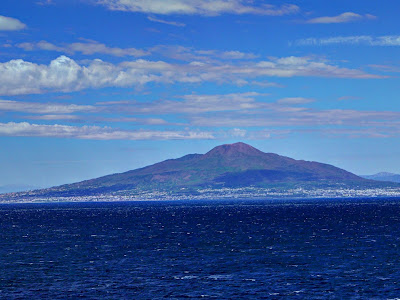Arrivederci Italia
(Goodbye Italy)
Thirty mile per hour (30 mph) winds blew all day long on our last day on the Amalfi Coast. Water travel became too big an adventure even for the ferries and jet boats and all boats remained docked. We were fortunate to have traveled to Capri the day before. As we always do, we adapted and played cards in a great card room and had the wind as background noise.
One of our favorite new friends was Alonzo who was genuinely friendly and helpful everyday. He and others we met on the trip were some of the reasons the four of us enjoyed our travel together.
We know there are mosquitos in Italy and some are super-sized. Unfortunately for two of the four of us, they were the preferred ‘food’ for the mosquitos. No matter where we went, there was one, maybe two mosquitos. I guess living in Utah makes you immune to mosquito bites.
Fortunately, the weather improved enough to get out. Jan and Debbie went to one of the many beaches and floated in the warm and wavy Mediterranean water while Shari and I wandered around town for some last views of Sorrento.
While on the Amalfi Coast, we found a flower shop with what we thought was a new flower I called the Colored Pencil Flower.
There are exotic flower varieties in Italy we’ve never seen in the U. S., but, this was a new one on us. When I asked for the name, I also asked if they were real. It turned out they are real except for the paint applied to the tips of the flower. I renamed them the Painted Pencil Flowers.
Speaking of flowers, I was lucky to have three beautiful and fun-loving women to accompany me. The four of us had a good time together for three (3) weeks in Italy, and I think we were excellent traveling companions. A special thanks to them for making me laugh and keep me on my toes!
As the day turned toward night, I took my last pictures of Sorrento. Arrivederci Italia!
Footnote1: After our last day in Sorrento, Jan and Debbie traveled to Rome for an additional two days of vacation before heading home. We were to fly out the next day, but, for the first time I can recall, our plane had mechanical problems such that we had to stay an extra day. It was a bit challenging, but we survived. It was one of those ‘what doesn’t kill you makes you stronger’ moments. Unlike most of the people of Pompeii, we ‘survived’ the extra day and traveled well on our way home.
Footnote2: On the following day, the plane did leave Rome. Un-expectantly, an older passenger tried to force his way into the cockpit half way over the Atlantic. Shari was coming out of the nearby bathroom when a stewardess yelled to her to get help because she couldn’t get the older gentleman to let go of the cockpit door knob. She got help and the crew escorted him to his seat. Unfortunately, the incident resulted in an unplanned detour to Boston to remove the man from the plane. As a result, we were late getting into Chicago and missed our flight home and ended up staying the night in Chicago. We weren’t the only ones.
The incident was quite a game changer as we were to have had a 5 hour layover in Chicago. It was to be a one day journey home that turned into 3 days. It’s amazing what you see and deal with when the unexpected happens - but, we are even stronger for it!

























































